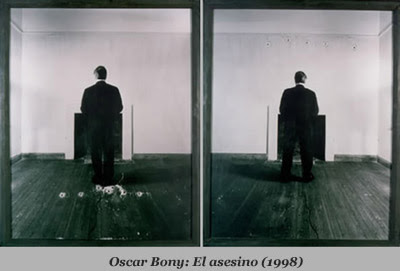
Museo de Arte Latinoamericano de Buenos Aires (MALBA) is the sparkly new museum of contemporary art in Buenos Aires. It exhibits an interesting collection of modern and contemporary Latin American art - including works from classic names like Antonio Berni, Diego Rivera and Frida Kahlo, but also pieces by the cream of the younger generation. Changing exhibitions feature design in addition to fine art and there are daily screenings of films from Argentina and abroad. For me, one of the high lights of the recent months' exhibitions was Oscar Bony, El Mago - the retrospective of Argentinian artist Oscar Bony (1941-2002).
Bony started out as a painter, but quickly ventured into variety of different modern art forms. His paintings literally grew into installations and sculptures, as he started experimenting with adding objects to his paintings. Bony became one of the "young rebels" of the Buenos Aires art scene, trying his hand at performances, happenings and video art, and finally focused mainly on photography.
Conceptual side was important in Bony's works through out his career. He sparked controversy with La Familia Obrera, in 1968. Bony hired a whole working class family to sit in the gallery, promising to double their hourly wage.
During the oppressive reign of the infamous military junta in Argentina, Bony among number of other artists stopped creating art for a number of years. "We undertook a fantastic utopia: unable to change society, we committed suicide", Bony later commented the resolution of his and his collegues. He then worked as a professional photographer, creating visual indentities for bands of the rock nacional-movement. He returned to the fine art in mid-70's, but soon moved to live in exile in Milan, where he actively participated the Europian art scene. Bony returned to Buenos Aires in '90s, working on photography, pictures typically framed behind a glass and then shot at with a 9 mm pistol.
There is something immensely powerful in the simple components Bony uses to construct his photographs. Often there's a picture of him, dressed in a dramatic black suit, his age clearly visible on his face. Or perhaps a faded picture of him as a young man. And there are brutal gun shot holes and shatters in the glass and the photograph behind it. Might almost sound corny, but the visual impact and certain strange ambiguity make these pictures unforgettable.
Thursday, January 31, 2008
Oscar Bony, the Magician
Lähettänyt
TeemuK
klo
3:38 PM
![]()
Tunnisteet: Argentina, art, Buenos Aires, photography




